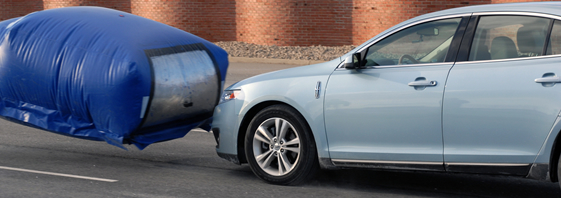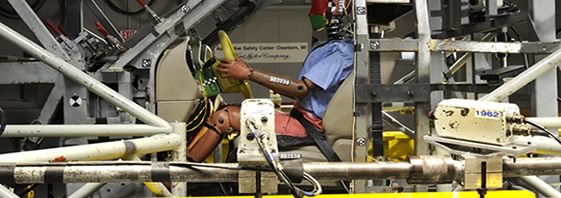Other Technologies and Research
-
Material Issues
- Materiality Analysis
- Climate Change
- Mobility
- Human Rights
-
Vehicle Safety
- Challenges and Opportunities
- How We Manage Vehicle Safety
-
Performance
- Human Behavior
- Vehicle Safety
- Driving Environment
- Other Technologies and Research
- Collaborative Efforts
- Data
- Case Studies
- Sustaining Ford
- Perspectives on Sustainability
Active Safety Research
Ford is undertaking a number of research efforts to assess and verify the effectiveness of new active safety technologies, such as those using forward-looking radar and vision sensors. For example, Ford, Volvo and the National Highway Traffic Safety Administration are jointly conducting a two-year study – the Advanced Crash Avoidance Technologies study – to develop methodologies for measuring and evaluating these technologies. This study will conclude in 2009.
One particularly creative research technique Ford has been using involves driving cars with Forward Collision Warning with Brake Support into large "balloons" nearly the size and shape of real cars. The purpose of these tests is to assess the accuracy of the radar and the timing of the warning signals and braking pre-charge. The balloons play the role of a "target" vehicle, allowing Ford engineers to assess the radar and braking features without endangering test drivers or damaging real cars. The balloons offer enough "give" to allow impact without injury. Ford uses about a dozen balloon cars in different sizes, each made from tarp-like material and weighing more than 40 pounds.

Ford testing new active crash-avoidance technologies
Servo Sled
In the fall of 2005, Ford commissioned the Servo-Hydraulic Reverse Crash Simulator, known as the Servo sled. This state-of-the-art system is reducing the time and resources required for Ford to research, design and build a new car or truck. Located inside Ford's Safety Innovation Lab in Dearborn, the Servo sled is the most capable crash simulator of its type in the world.
The Servo sled builds on the basic principle of the Hyge sled, a crash test simulator Ford has used for more than 40 years. The Hyge and Servo sleds each sit inside a corridor about the width of a two-lane highway and about 50 yards long. A track runs the length of the corridor with the sled on top of it. On top of the sled sits a "buck" – an accurate representation of the interior of the vehicle to be tested (including seats, instrument panel, windshield, airbags, seat belts, etc.). Crash test dummies are positioned in the buck.
To launch a test, the buck and sled are propelled to more than 35 mph in a few milliseconds. The sled and buck can be used again, but the seats, seat belts, airbags and so forth must be replaced before another test can be performed.
The Servo sled is a significant improvement over the Hyge, for several reasons. Most important, it more accurately represents a vehicle's "pulse," or the acceleration experienced in the occupant compartment during a full vehicle crash test. This reduces the number of full crash tests that must be conducted. The Servo sled can also simulate vehicle pitching and side-impact events, which the Hyge cannot. In short, the new Servo sled allows more representative testing in a given time period, with fewer resources than previously, and enables Ford to more quickly bring safety features to market.

Servo-Hydraulic Reverse Crash Simulator, known as the Servo sled
Related Links
- External Web Sites: